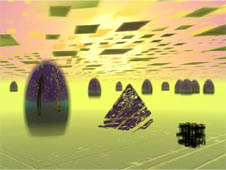Computers and Information Technology
Why ship atoms when you ship bits?
- Nicholas Negroponte
Information technology is essential for all advanced societies, and the pressure to develop faster, more efficient, more clever and more extensive computer networks has been intense on most planets. Modern computers are based on three-dimensional blocks of micro-optical circuitry, using laser light instead of electricity. Memory storage is done using opsin cubes, using light-sensitive molecules to store information. Usually the entire computer is manufactured as a solid block that is linked wirelessly to peripherals or other blocks in the vicinity.
Wearable computers are common on many worlds, computers hidden in the clothing that display information through glasses, contact lenses, earphones or even graphical fabrics. On Nova and Atlantis neural interfaces are popular.
Planetary communications network exist on all colonies that have retained their technology. At the lowest level, they consist of high bandwidth optical fibre networks covering inhabited areas and supplemented by wireless communication. Usually it is enough to be within a few hundred meters of a network interface node to get full access to the system. Since people are often spread out, dense satellite constellations orbit the colonies to support satellite-based networking. These communications networks support a diverse world of communication, interaction, processing and information storage. The interfaces used depend on the network and the application; usually agent programs are used to bring up information, but various browsers are used to surf in person (full 3D immersion visualisation of the networks certainly exist, but it is little used since it is slow, inefficient and limits what the user can do compared to more streamlined interfaces).
Unless the computer is extremely powerful or the object is quite small, computers do not take up extra space in anything. Miniaturisation has gone a long way, and the next generation of nanocomputers will be even smaller.
Knowledge Nets
Without going outside, you may know the whole world!
-Chap. 47, Tao Te-Ching
Beyond simple information networks, knowledge networks allow information to be searched and processed depending on meaning rather than syntax. This makes information processing much more powerful, amplifying the effective abilities of most users significantly. Global knowledge networks exist on Nova, Atlantis and to some extent New America. Local specialised knowledge nets are in use on many worlds, as part of help systems, smart equipment and professional computer systems.
[ Knowledge nets give a –1 bonus or more to tasks where information or support from the net can be helpful (almost any mental task). In global networks popular questions or problems ("How do I navigate from here to there?") get an even better –2 or more bonus. ]
Comdust
Small (a few millimetres), wireless data-transmitter chips that spontaneously link up into a computer network when released into the environment. While most indoor or urban environments on Nova, Atlantis, New America and many other colonies are already saturated with linkable bandwidth, sometimes it is necessary to set up a network outdoors or do it so that outsiders cannot access it. Each Comdust chip has a rather short range (a few meters at most), but since the chips can be spread out they can cover a large area with communications. This is used by Nova homeowners to make their gardens net-linked (if they don't want to place larger and stronger transponders in bushes, fences, garden gnomes or whatever), as well as part of the C3I system of the Landfall police and other law or military groups. The chips runs on solar power or batteries (which last for a few hours at moderate use).
One way of spreading the dust is the combullet, a bullet or grenade loaded into an ordinary weapon. When fired, it will release comdust along its flight and the grenade will burst out a cloud of chips. This is a practical way of quickly setting up lines of communication for a C3I team.
Docusphere
A common device on Nova. A small black sphere, containing 360 degree
vision and audio that transmits everything it sees to someplace on the
Net (such as the owner’s account or a public viewing space). By placing
several docuspheres in an area an accurate 3D rendition of the scene can
be created. The standard docuspheres are the size of beads, they are sometimes
sewn into the clothing or scattered around. Professional docuspheres can
be much smaller; Paparazzi spheres are often sub-millimetre and can be
scattered nearly invisibly. There are also scientific and specialised
spheres with sensitivity to different forms of energy or radiation, and
interview spheres ("talk orbs") the size of a fist for the highest
quality recordings.
